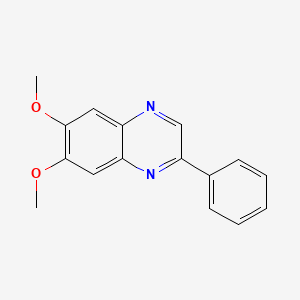Drug Information
Drug (ID: DG01463) and It's Reported Resistant Information
| Name |
AG1296
|
||||
|---|---|---|---|---|---|
| Synonyms |
146535-11-7; Tyrphostin AG 1296; 6,7-dimethoxy-2-phenylquinoxaline; AG-1296; AG 1296; 6,7-Dimethoxy-3-phenylquinoxaline; ag1296; Tyrphostin AG-1296; Quinoxaline, 6,7-dimethoxy-2-phenyl-; Tyrphostin AG1296; CHEMBL71191; MFCD00270913; tyrphostin-AG1296; 6,7-Dimethoxy-2-phenylquinozaline; tyrphostin-AG-1296; BiomolKI_000055; BiomolKI2_000061; BMK1-F7; BSPBio_001422; KBioGR_000142; KBioSS_000142; SCHEMBL595944; GTPL5915; QCR-71; ZINC8082; CHEBI:93335; KBio2_000142; KBio2_002710; KBio2_005278; KBio3_000283; KBio3_000284; DTXSID70163393; Bio2_000142; Bio2_000622; HMS1361H04; HMS1791H04; HMS1989H04; HMS3229M21; HMS3402H04; HMS3653H21; BCP06928; EX-A4245; Tyrphostin AG 1296, >=98%; 6,7-Dimethoxy-2-phenyl-quinoxaline; 2090AH; 2774AH; BDBM50154227; s8024; AKOS025287463; CCG-100659; Quinozaline, 6,7-dimethoxy-2-phenyl-; Tyrphostin AG 1296 (AG 1296); IDI1_033892; NCGC00163386-01; NCGC00163386-02; NCGC00163386-03; NCGC00163386-04; AS-62520; HY-13894; CS-0008498; SW220231-1; AG-1296; ; ; 6,7-Dimethoxy-2-phenylquinoxaline; SR-03000001061; J-008233; SR-03000001061-1; AG 1296 - CAS 146535-11-7; BRD-K76064317-001-03-2; BRD-K76064317-001-04-0; Q27074335
Click to Show/Hide
|
||||
| Indication |
In total 1 Indication(s)
|
||||
| Structure |

|
||||
| Target | Acetylcholinesterase (AChE) | ACES_HUMAN | [2] | ||
| Click to Show/Hide the Molecular Information and External Link(s) of This Drug | |||||
| Formula |
3
|
||||
| IsoSMILES |
COC1=C(C=C2C(=C1)N=CC(=N2)C3=CC=CC=C3)OC
|
||||
| InChI |
InChI=1S/C16H14N2O2/c1-19-15-8-12-13(9-16(15)20-2)18-14(10-17-12)11-6-4-3-5-7-11/h3-10H,1-2H3
|
||||
| InChIKey |
QNOXYUNHIGOWNY-UHFFFAOYSA-N
|
||||
| PubChem CID | |||||
| ChEBI ID | |||||
| TTD Drug ID | |||||
Type(s) of Resistant Mechanism of This Drug
Drug Resistance Data Categorized by Their Corresponding Diseases
ICD-02: Benign/in-situ/malignant neoplasm
| Drug Sensitivity Data Categorized by Their Corresponding Mechanisms | ||||
|
|
||||
| Key Molecule: Receptor-type tyrosine-protein kinase FLT3 (FLT3) | [2] | |||
| Molecule Alteration | IF-deletion | p.Q569_G613 (c.1705_1837) |
||
| Sensitive Disease | Acute myeloid leukemia [ICD-11: 2A60.0] | |||
| Experimental Note | Identified from the Human Clinical Data | |||
| In Vitro Model | Bone marrow | N.A. | ||
| Experiment for Molecule Alteration |
Immunoprecipitation and immunoblot analysis | |||
| Experiment for Drug Resistance |
MTT assay | |||
| Mechanism Description | The if-deletion p.Q569_G613 (c.1705_1837) in gene FLT3 cause the sensitivity of AG1296 by unusual activation of pro-survival pathway. | |||
| Key Molecule: Receptor-type tyrosine-protein kinase FLT3 (FLT3) | [1] | |||
| Molecule Alteration | Missense mutation | p.D835V (c.2504A>T) |
||
| Sensitive Disease | Acute myeloid leukemia [ICD-11: 2A60.0] | |||
| Experimental Note | Revealed Based on the Cell Line Data | |||
| In Vitro Model | Ba/F3 cells | Colon | Homo sapiens (Human) | CVCL_0161 |
| Experiment for Molecule Alteration |
Western blotting analysis | |||
| Experiment for Drug Resistance |
Cell proliferation Kit II XTT assay | |||
| Mechanism Description | The missense mutation p.D835V (c.2504A>T) in gene FLT3 cause the sensitivity of AG1296 by unusual activation of pro-survival pathway | |||
References
If you find any error in data or bug in web service, please kindly report it to Dr. Sun and Dr. Zhang.
